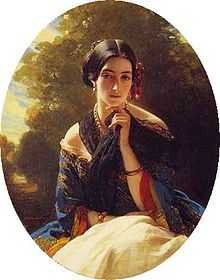Princess Leonilla Bariatinskaya
| Leonilla Bariatinskaia | |
|---|---|
 | |
| Portrait by Franz Xaver Winterhalter | |
| Spouse | Ludwig zu Sayn-Wittgenstein-Berleburg |
| Full name | |
| Leonilla Ivanovna Bariatinskaya Princess of Sayn Wittgenstein Sayn | |
| Father | Prince Ivan Bariatinsky |
| Born | 9 May 1816 Moscow |
| Died | 1 February 1918 (aged 101) Lausanne |
Leonilla Ivanovna Bariatinskaia Princess of Sayn Wittgenstein Sayn (Russian: Леонилла Ивановна Барятинская) (9 May 1816 – 1 February 1918) was a Russian aristocrat who married Ludwig, Prince of Sayn-Wittgenstein-Sayn. Known for her great beauty and intellect, Princess Leonilla was the subject of a number of portraits by Franz Xaver Winterhalter.
Life
Princess Leonilla Ivanovna Bariatinskaya was born on 9 May 1816 in Moscow. She was a daughter of Field-Marshal Prince Ivan Ivanovich Bariatinsky, a member of one of the most influential families of the Russian nobility. She married one of the Tsar’s aides de camp, Ludwig, Prince of Sayn-Wittgenstein-Berleburg (1799-1866) on 23 October 1834 at Castle Marino, Kursk Oblast. He was a Russian aristocrat of German descent, who was known in Russia as Lev Petrovich Wittgenstein. He was a son of Ludwig, first Prince of Sayn-Wittgenstein and Caecilia Snarska. Her husband had been previously married to Princess Stephanie Radziwil, who left him on her early death a rich large estate in central Europe and two children: Peter (who died without issue), and a daughter Marie, wife of Prince Chlodwig zu Hohenlohe-Schillingsfürst, Chancellor of the German Empire.[1]
Princess Leonilla and her husband had four children. Her beauty created an impression at the Russian court, but her husband fell from favor perhaps because his liberal treatment of his serfs. They left Russia in 1848. The Prince received, as a present from King Friedrich Wilhelm IV of Prussia, the former family seat Sayn Castle, which had been destroyed in the Thirty Years' War. With the purchase of a former knight’s manor in Sayn he gained the title of Prince (Fürst) zu Sayn-Wittgenstein-Sayn. They had extensive landholdings in Russia. Among their properties were Pavlino; Kamenka, south of Kiev; and Werki, in what is now Lithuania. Princess Leonilla, who converted to Catholicism, preferred Rome and Paris, where she witnessed the pillage of the Tuileries in 1848. The princely family moved from country to country with the seasons taking with them their children, pets, servants and tutors.
Ludwig and Leonilla had the former Baroque manor of the Counts of Boos-Waldeck below Sayn Castle reconstructed into a princely residence in Gothic Revival style. Their youngest son Alexander married Yvonne, the daughter of the French Duke of Blacas and inherited Sayn after the morganatic marriages of his older brothers Peter, Friedrich and Ludwig. After his wife's early death he remarried and spent his life as Count of Hachenburg in the former family residences in Hachenburg and Friedewald in the Westerwald. Princess Leonilla held a monarchist and Catholic salon and died in 1918 at the age of 101 at her villa of Mon Abri on Lake Geneva, Switzerland.[2]
Winterhalter's portraits

Known for her great beauty and intellect, Princess Leonilla was the subject of a number of portraits by Franz Xaver Winterhalter.[3] The most famous of these is the one currently at the J. Paul Getty Museum in Los Angeles. It is signed and dated in 1843 in the pillar on the right. Winterhalter opted for a daring portrait, unusual in his oeuvre, both in conception and format.[4]
Princess Leonilla appears reclined on a low Turkish sofa on a veranda overlooking a lush tropical landscape, possibly the Wittgenstein palace in the Crimea, even though the portrait was painted in Paris. Her pose is reminiscent of harem scenes and odalisque. It was probably inspired by Jacques-Louis David's portrait of Madame Récamier (1800) and Ingres's Grande Odalisque (1819). The Princess is wearing a luxurious gown of ivory silk moiré with a pink sash around her waist. A deep purple mantle wraps around her back and falls across her arms. She gazes languidly at the viewer while she toys with the large pearls around her neck in an indolent gesture, reinforcing the sensuality of the model. Winterhalter contrasted the sumptuous fabrics and vivid colors against the Princess's alabaster flesh to heighten the sensuality of the pose, the model, and the luxuriant setting.[5]
The oval portrait it is also signed but not dated. Its dimensions are 97 × 79 cm and it still belongs to the princess's descendants. It was painted years earlier, probably in 1836 in Rome when Winterhalter met the Princess of Sayn-Wittgenstein-Sayn and her husband and made portraits of both of them. Princess Leonilla of Sayn-Wittgenstein-Sayn appears wearing a loose bodice, blue-lined with scarlet, over a white skirt.[6] She has a black lace scarf draped around her shoulders. She is wearing pearl earrings and necklace. She is seated, with one hand in her lap, the index finger of the other rest on her chin in a confident gesture.[7]
Notes
- ↑ Ormond & Blackett-Ord, Franz Xaver Winterhalter and the Courts of Europe, p. 185.
- ↑ Ormond & Blackett-Ord, Franz Xaver Winterhalter and the Courts of Europe, p. 185.
- ↑ Ormond & Blackett-Ord, Franz Xaver Winterhalter and the Courts of Europe, p. 185.
- ↑ Ormond & Blackett-Ord, Franz Xaver Winterhalter and the Courts of Europe, p. 185.
- ↑ Ormond & Blackett-Ord, Franz Xaver Winterhalter and the Courts of Europe, p. 185.
- ↑ Ormond & Blackett-Ord, Franz Xaver Winterhalter and the Courts of Europe, p. 189.
- ↑ Ormond & Blackett-Ord, Franz Xaver Winterhalter and the Courts of Europe, p. 189.
References
| Wikimedia Commons has media related to Leonilla Ivanovna Sayn-Wittgenstein (Baryatinskaya). |
- Ormond, Richard, and Blackett-Ord, Carol, Franz Xaver Winterhalter and the Courts of Europe, 1830–70, Exh. cat. National Portrait Gallery, London, 1987. ISBN 0-8109-3964-9.